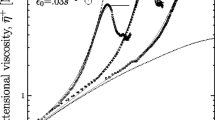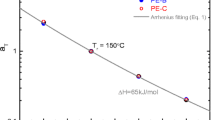Summary
Two different apparatuses for measuring the elongational behaviour of polymer melts at constant tensile stress and constant elongational strain rate are described. Measurements on a low density polyethylene were carried out up to stretching ratios of 400. The homogeneity of sample deformation in both test methods was sufficient to reach a steady-state of elongational flow where the tensile stress and the strain rate as functions of time are constant. By unloading the molten rod the recoverable strain can be determined at any state of deformation. The recoverable strain increases with growing deformation and reaches a constant value in the steady-state. The elongational viscosity calculated from the rate of viscous flow agrees with the Trouton viscosity in the case of very small deformations only. With growing deformation the elongational viscosity increases up to a constant value in the steady-state which is greater than the Trouton viscosity by about a factor of six at measured strain rates of 0.03 s−1 and 0.1 s−1, respectively. The elongational viscosity and the recoverable strain in the steady-state measured with the two different test methods under the same experimental conditions are in good agreement.
Zusammenfassung
Zwei verschiedene Apparaturen zur Untersuchung des Dehnverhaltens von Polymerschmelzen unter konstanter Zugspannung und konstanter Dehngeschwindigkeit werden beschrieben. An einem Polyäthylen niedriger Dichte wurden Messungen bis zu Verstreckgraden von 400 durchgeführt. Die ausreichend homogene Probenverformung erlaubt in beiden Versuchsführungen das Erreichen eines stationären Dehnfließens mit zeitlich konstanter Zugspannung und Dehngeschwindigkeit. Durch Entlasten des Schmelzestranges ist der reversible Dehnungsanteil für jeden Verformungszustand direkt zu messen. Die reversible Dehnung steigt mit wachsender Dehnverformung an, bis sich im stationären Bereich ein konstanter Wert einstellt. Die aus der Geschwindigkeit des viskosen Dehnfließens berechnete Dehnviskosität stimmt nur für den Grenzfall kleiner Deformationen mit der Trouton-Viskosität überein. Mit wachsender Dehndeformation steigt die Dehnviskosität bis zu einem Gleichgewichtswert an, der bei den gemessenen Dehngeschwindigkeiten von 0,03 s−1 und 0,1 s−1 um etwa einen Faktor 6 über dem Wert der Trouton-Viskosität liegt. Die unter gleichen Versuchsbedingungen mit beiden Apparaturen bestimmten Dehnviskositäten und reversiblen Dehnungen im stationären Bereich stimmen überein.
Similar content being viewed by others
References
Dealy, J. M. Polym. Eng. Sci.11, 433–445 (1971).
Cogswell, F. N. Appl. Polymer Symposium27, 1–18 (1975).
White, J. L., Y. Ide Appl. Polymer Symposium27, 61–102 (1975).
Meissner, J. Pure and Applied Chemistry42, 553–612 (1975).
Meissner, J. Trans. Soc. Rheol.16, 405–420 (1972).
Meissner, J. Rheol. Acta10, 230–242 (1971).
Münstedt, H. Rheol. Acta14, 1077–1088 (1975).
Vinogradov, G.V., V.D. Fikhman, B.V. Radushkevich Rheol. Acta11, 286–291 (1972).
Cogswell, F. N., Plastics and Polymers 109–111 (1968).
Trouton, F. T. Proc. Roy. Soc.A77, 426–440 (1906).
Author information
Authors and Affiliations
Additional information
With 10 figures and 2 tables
Rights and permissions
About this article
Cite this article
Laun, H.M., Münstedt, H. Comparison of the elongational behaviour of a polyethylene melt at constant stress and constant strain rate. Rheol Acta 15, 517–524 (1976). https://doi.org/10.1007/BF01515874
Received:
Issue Date:
DOI: https://doi.org/10.1007/BF01515874




